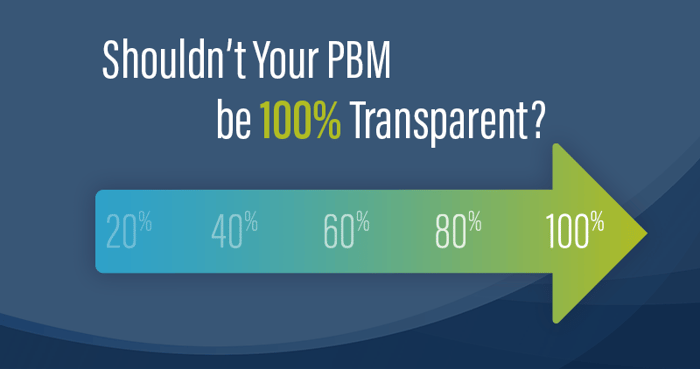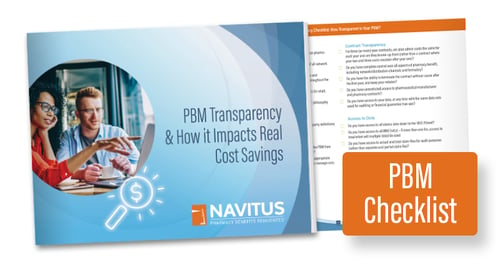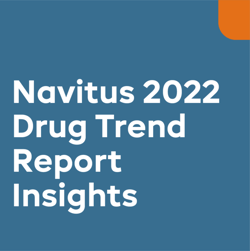Didn’t catch our webinar last week? Read on to see what you missed!

Although transparency is a widely used term across pharmacy benefit managers (PBMs), very few are truly 100% transparent. If yours isn’t, chances are you’re paying too much.
During last week’s webinar, Navitus’ Byron Mickle and Mike Krause shared their industry insights on how PBMs are talking about transparency and what that really means for your pharmacy benefit plan costs. Here’s what you need to know:
What is the Market Saying About PBM Transparency?
To kick things off, Mike spent a couple minutes talking about the PBM industry in general.
He pointed out that a general lack of trust and skepticism of PBM business practices exists. Only 35% of employers consider their PBM “very trustworthy,” and 63% believe PBMs lack transparency about how they make money.1
To combat this in the industry, many states have begun passing laws that will require more transparency in PBM business practices. As of January 2020, 48 states are considering over 665 bills covering a range of topics related to PBMs, including, drug pricing, transparency, licensure/registration, step therapy, gag clauses, clawback prohibitions, pharmacy networks and copay accumulator bans.2
Mike shared that,
"We see legislation that touches on pricing or transparency related to PBMs in just about every state in the country. And it's not just PBMs, of course, it's also different areas of the supply chain, notably pharmaceutical manufacturers as well. Certainly, a logical question to ask is: How did we get here? I don't think that too many people would argue at this point that it has everything to do with what has been essentially an unchecked, unregulated aspect of health care for far too long. It's simply caused tremendous misalignment with respect to how pharmacy benefit managers operate in respect to what plan sponsors and health plans expect. And to some extent, you could say the same with manufacturers.”
What Does True Transparency Really Mean?
PBM transparency means visibility into drug prices, benefit plan costs and operational components. So why is this important?
When you have complete transparency, you eliminate the possibility of surprises in your PBM contract. And, if you don’t have complete transparency, you may experience hidden expenses that could be costing you more than you were expecting.
Despite the lack of a standard definition of transparency, many consultants and plan sponsors overlook one important factor when evaluating PBM transparency. Transparency is not only a financial term, but it’s also an operational way of doing business.
True financial transparency means you have access to view and audit documents, data, network pharmacy arrangements, pharma contracts and claims data. A truly transparent PBM will allow you to view and access ALL of these items.
From an operational perspective, Mike explained:
“Transparency should be available as it relates to decisions around what drugs are covered. Why are they placed on the formulary? What is the thought process behind…decisions around utilization management and prior authorization criteria? By way of example, Navitus extends access to our Formulary Advisory Committee, as well as our P&T Committee. Most people don’t know this, but it is just a matter of process. So, if you want to listen in, you can do so without restriction from beginning to end... And even if you never listen in to these, this will give you the peace of mind that your PBM is aligned and doing the right thing.”
How Do You Achieve Contract Transparency?
During the webinar, Byron shared that two approaches to PBM contracting exist - simple and complex.
He emphasized contract importance because it governs how your benefit plan will perform. It doesn’t take a complex, 150+ page contract to outline that. For example, allowing a PBM to define ‘what is a brand’ and ‘what is a generic’ in the contract is like handing over the keys to your car. That becomes a fundamental driver in determining how claims are bucketed and how your plan will perform.
Also, Byron explained that plans should be keenly attuned to words like ‘proprietary’ or the use of 'algorithms.' These can be code for “you’ll never know.”
A truly transparent PBM contract includes the following:
- Straightforward caveat language and third-party industry source definitions
- Unrestricted audit rights down to the NDC-11 claim level
- Access to PBM’s pharmaceutical manufacturer and pharmacy contracts
- Access and authorization to use to all of your plan’s data at any time, with the same data used for an audit or financial guarantee true-ups
As a rule of thumb, it’s better to start with a partner that aligns with your interests where the PBM offering is already in the contract. If it’s not, it’s harder to work what you want back into an otherwise more complex, legalese-based contract.
Want to hear more? Watch the webinar on-demand here!
Or, to learn more, check out our e-book on transparency and download the complete checklist to achieving PBM transparency.
- Toward Better Value: Employer Perspectives on What’s Wrong with the Management of Prescription Drug Benefits and How to Fix it. National Pharmaceutical Council. https://www.npcnow.org/publication/toward-better-value. Published October 25, 2017.
- Internal Navitus Research. 2020.






